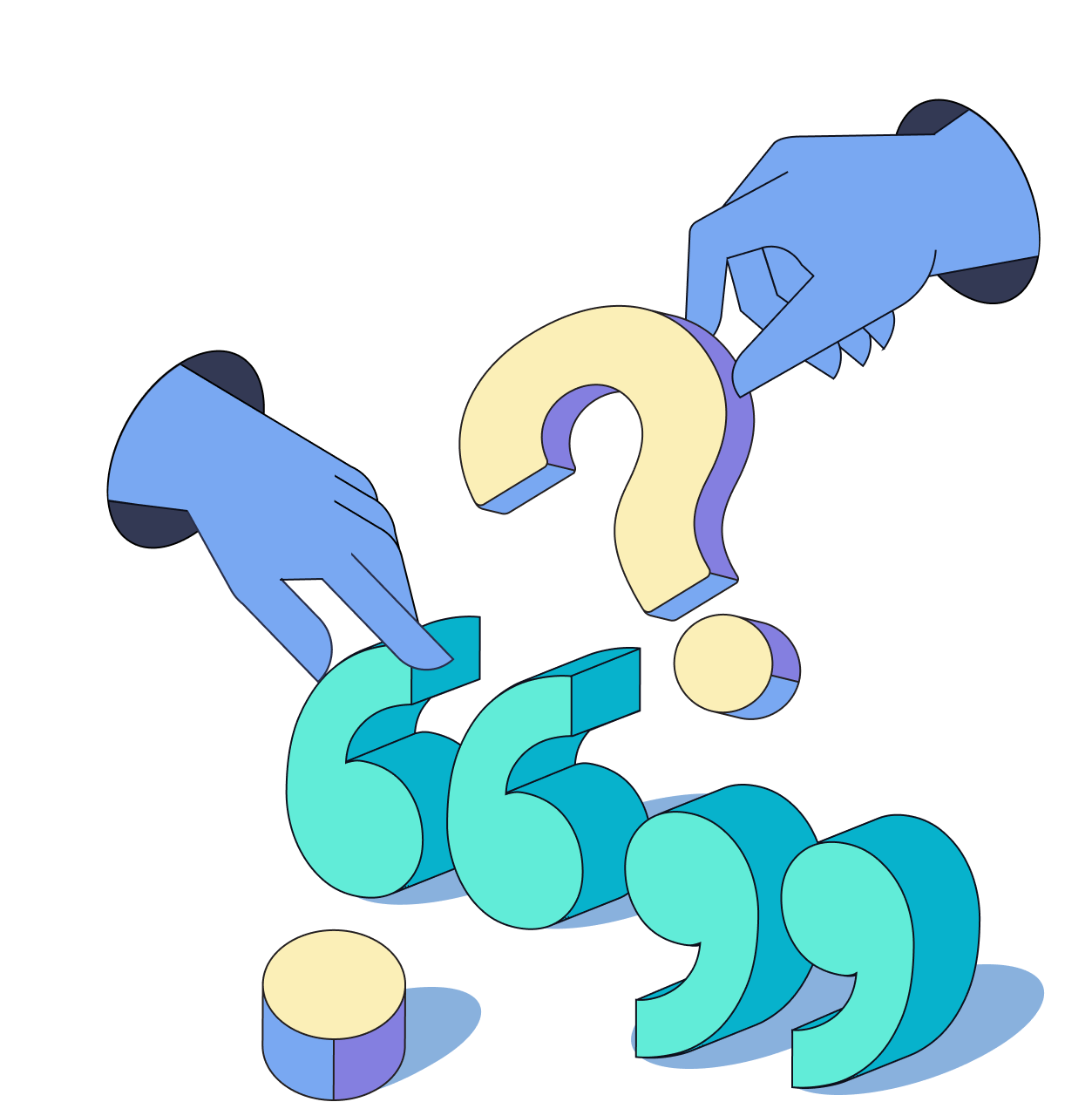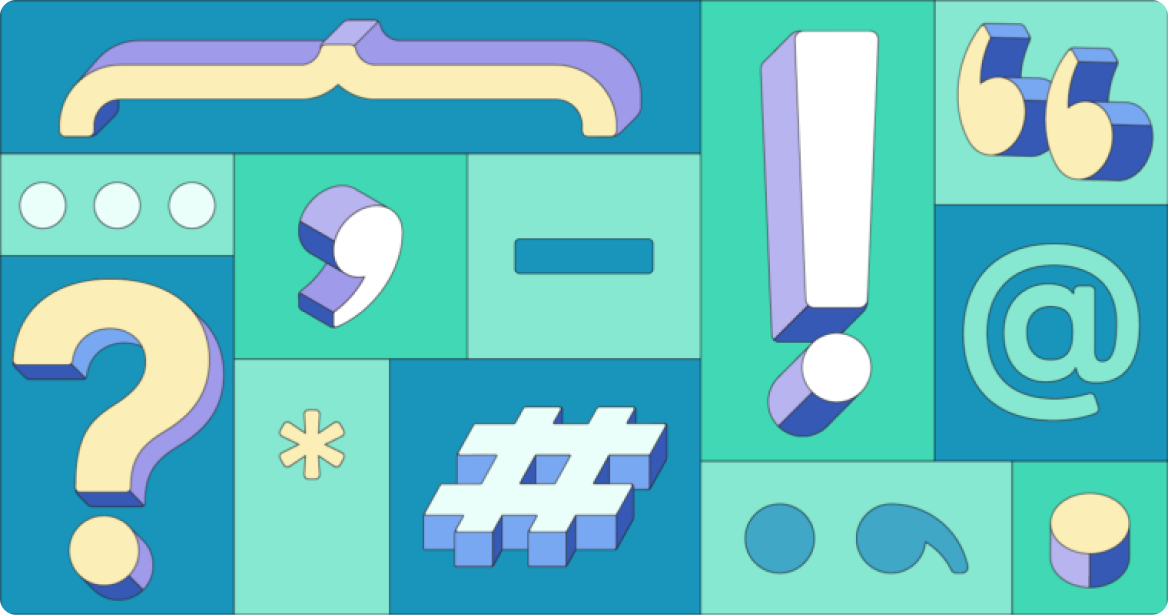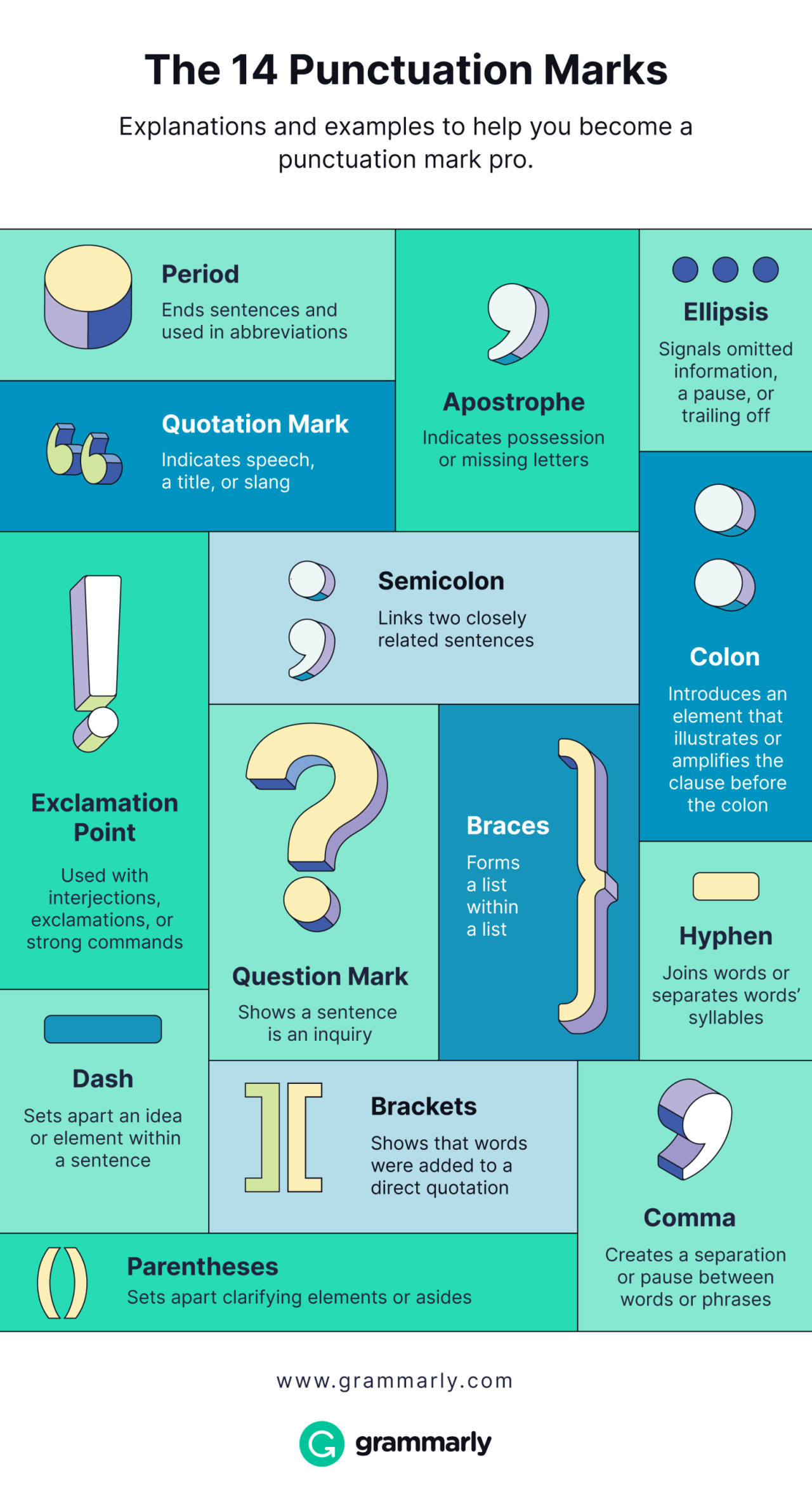Punctuation
Everything You Need to Know About Punctuation in English
Let’s face it: Punctuation in English can be complicated. If you’ve ever wondered, “Do I need a comma here?” or “Does punctuation go inside quotations?”—or if you’re just looking for a free grammar and punctuation checker—this page is for you.
Jump to Section:
What Is Punctuation?
Your Guide to Punctuation in English
The 14 Punctuation Marks
Grammar and Punctuation Checker
Frequently Asked Questions


What Is Punctuation?
Punctuation is defined as a set of symbols used to separate and clarify the meaning of sentences and written elements. In other words, punctuation tells readers of your writing where to pause, what words are quotations and which are clarifications, where words have been omitted, and more. Read the resources below to get up to speed on commas, hyphens, semicolons, and all other punctuation marks.
Perfect Your Punctuation
Grammarly’s punctuation checker helps make your writing polished and clear. With its help, you’ll never miss a comma, misplace a period, use quotation marks questionably, or make any other punctuation mistakes.
Your Guide to Punctuation in English
Learn the ins and outs of the types of punctuation and punctuation rules with the help of this handy guide to acing apostrophes, perfecting parentheses, excelling at exclamation marks, and more.

The 14 Punctuation Marks
Watch and Learn
Explore how to properly use punctuation marks in your writing—including important rules to follow and other helpful tips.
Semicolons
Semicolons don’t have to be intimidating for writers to use. Watch Grammarly’s breakdown of how to use them correctly every time.
Commas
Grammarly looks at 11 writing scenarios where you’ll want to use commas—with examples.
Colons
Colons can be tricky for writers to understand. That’s why Grammarly has provided a roundup of helpful advice on how and when to use them properly.
Quotation Marks
Learn more about how to properly use quotation marks in your writing—including use cases and essential rules to follow.
Semicolons
Semicolons don’t have to be intimidating for writers to use. Watch Grammarly’s breakdown of how to use them correctly every time.
Commas
Grammarly looks at 11 writing scenarios where you’ll want to use commas—with examples.
Colons
Colons can be tricky for writers to understand. That’s why Grammarly has provided a roundup of helpful advice on how and when to use them properly.
Quotation Marks
Learn more about how to properly use quotation marks in your writing—including use cases and essential rules to follow.

Grammar and Punctuation Checker
Eliminate punctuation mistakes and fine-tune your writing with the help of this free grammar and punctuation checker.
Frequently Asked Questions
What is punctuation and what are examples of it?
Punctuation is a series of marks that clarify the meaning of a piece of writing. There are 14 punctuation marks; commas, periods, apostrophes, parentheses, and quotation marks are some of the most commonly used ones.
What are the 14 punctuation marks?
The 14 punctuation marks in English are period (called “full stop” in the UK), question mark, exclamation point, comma, colon, semicolon, dash, hyphen, brackets, braces, parentheses, apostrophe, quotation mark, and ellipsis.
What are the most important punctuation rules?
There are plenty of important punctuation rules, but here are five you should know:
1. All sentences must end in a period, a question mark, an exclamation point, or, if followed by a closely related sentence, a semicolon.
2. Commas and periods always go inside quotation marks in American English; dashes, colons, and semicolons almost always go outside. Question marks and exclamation marks sometimes go inside and sometimes stay outside.
3. Always use quotation marks, brackets, braces, and parentheses in pairs.
Example: They asked, “Is cereal [once you add milk] considered soup?”
4. If an explanatory element is nonessential (i.e., it doesn’t change the meaning of a sentence if you leave it out), set it apart with commas.
Correct: Earth’s oldest tree, Methuselah, is over 4,800 years old.
Incorrect: Earth’s oldest tree Methuselah is over 4,800 years old.
Correct: The inventor Leonardo da Vinci was multitalented.
Incorrect: The inventor, Leonardo da Vinci, was multitalented.
5. Introductory elements can be used at the beginning of a sentence to modify or provide background for the main part of the sentence. Always put a comma after them.
Example: On the long drive home, they concluded the meaning of life is indeed 42.
1. All sentences must end in a period, a question mark, an exclamation point, or, if followed by a closely related sentence, a semicolon.
2. Commas and periods always go inside quotation marks in American English; dashes, colons, and semicolons almost always go outside. Question marks and exclamation marks sometimes go inside and sometimes stay outside.
3. Always use quotation marks, brackets, braces, and parentheses in pairs.
Example: They asked, “Is cereal [once you add milk] considered soup?”
4. If an explanatory element is nonessential (i.e., it doesn’t change the meaning of a sentence if you leave it out), set it apart with commas.
Correct: Earth’s oldest tree, Methuselah, is over 4,800 years old.
Incorrect: Earth’s oldest tree Methuselah is over 4,800 years old.
Correct: The inventor Leonardo da Vinci was multitalented.
Incorrect: The inventor, Leonardo da Vinci, was multitalented.
5. Introductory elements can be used at the beginning of a sentence to modify or provide background for the main part of the sentence. Always put a comma after them.
Example: On the long drive home, they concluded the meaning of life is indeed 42.
How do you punctuate a sentence?
All sentences need punctuation at the end. You can use a period to express a neutral tone, a question mark to show that the sentence is an inquiry, or an exclamation point to indicate excitement or a command. You can also end a sentence with a semicolon if a different, closely related sentence follows that sentence. Here’s an example that shows how each of these punctuation marks work:
Do I like cheese? No, I don’t like cheese. I love it! There are so many kinds of cheese; I never get bored.
Do I like cheese? No, I don’t like cheese. I love it! There are so many kinds of cheese; I never get bored.
How can I use a comma in a sentence?
Commas may be the most varied and versatile punctuation mark in English. Here are the most common ways they’re used, complete with examples:
1. To separate words or elements in a list.
Example: Bats, whales, and goats develop regional accents.
2. After introductory phrases.
Example: Today, I discovered bamboo can grow up to 35 inches in one day.
3. To separate complete sentences joined by a coordinating conjunction (and, but, for, or, nor, so, yet).
Example: Polar bears look white, but their skin is black.
4. To surround elements in the middle of a sentence that are not essential to the sentence’s meaning.
Example: Vanilla, a popular flavoring in desserts, comes from orchids.
5. To separate two or more adjectives describing one noun.
Example: The bright, golden sun shone upon the lawn.
Learn more ways to use commas.
1. To separate words or elements in a list.
Example: Bats, whales, and goats develop regional accents.
2. After introductory phrases.
Example: Today, I discovered bamboo can grow up to 35 inches in one day.
3. To separate complete sentences joined by a coordinating conjunction (and, but, for, or, nor, so, yet).
Example: Polar bears look white, but their skin is black.
4. To surround elements in the middle of a sentence that are not essential to the sentence’s meaning.
Example: Vanilla, a popular flavoring in desserts, comes from orchids.
5. To separate two or more adjectives describing one noun.
Example: The bright, golden sun shone upon the lawn.
Learn more ways to use commas.
How can I improve my punctuation?
Don’t puzzle over tedious grammar rules for hours when you can use our punctuation checker to improve your writing. Ensure your text is clear, compelling, and mistake-free when you use our browser extension and desktop app—available with Grammarly Free.
Write with Confidence
Join over 30 million people who use Grammarly
to make their writing shine.
to make their writing shine.

